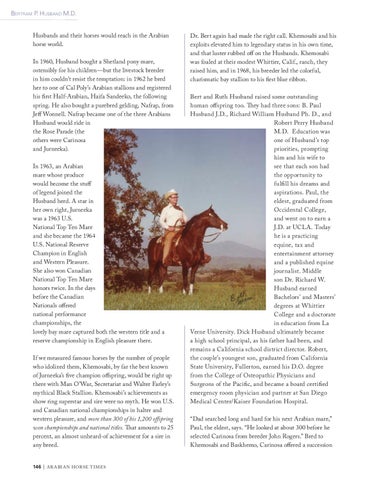Bertram P. HusBand m.d. Husbands and their horses would reach in the Arabian horse world. In 1960, Husband bought a Shetland pony mare, ostensibly for his children—but the livestock breeder in him couldn’t resist the temptation: in 1962 he bred her to one of Cal Poly’s Arabian stallions and registered his first Half-Arabian, Haifa Sandeeko, the following spring. He also bought a purebred gelding, Nafrap, from Jeff Wonnell. Nafrap became one of the three Arabians Husband would ride in the Rose Parade (the others were Carinosa and Jurneeka). In 1963, an Arabian mare whose produce would become the stuff of legend joined the Husband herd. A star in her own right, Jurneeka was a 1963 U.S. National Top Ten mare and she became the 1964 U.S. National Reserve Champion in English and Western Pleasure. She also won Canadian National Top Ten mare honors twice. In the days before the Canadian Nationals offered national performance championships, the lovely bay mare captured both the western title and a reserve championship in English pleasure there. If we measured famous horses by the number of people who idolized them, Khemosabi, by far the best known of Jurneeka’s five champion offspring, would be right up there with man O’War, Secretariat and Walter Farley’s mythical Black Stallion. Khemosabi’s achievements as show ring superstar and sire were no myth. He won U.S. and Canadian national championships in halter and western pleasure, and more than 300 of his 1,200 offspring won championships and national titles. That amounts to 25 percent, an almost unheard-of achievement for a sire in any breed. 146 | A R A BI A N HOR SE T I mES
dr. Bert again had made the right call. Khemosabi and his exploits elevated him to legendary status in his own time, and that luster rubbed off on the Husbands. Khemosabi was foaled at their modest Whittier, Calif., ranch, they raised him, and in 1968, his breeder led the colorful, charismatic bay stallion to his first blue ribbon. Bert and Ruth Husband raised some outstanding human offspring too. They had three sons: B. Paul Husband J.d., Richard William Husband Ph. d., and Robert Perry Husband m.d. Education was one of Husband’s top priorities, prompting him and his wife to see that each son had the opportunity to fulfill his dreams and aspirations. Paul, the eldest, graduated from Occidental College, and went on to earn a J.d. at UCLA. Today he is a practicing equine, tax and entertainment attorney and a published equine journalist. middle son dr. Richard W. Husband earned Bachelors’ and masters’ degrees at Whittier College and a doctorate in education from La Verne University. dick Husband ultimately became a high school principal, as his father had been, and remains a California school district director. Robert, the couple’s youngest son, graduated from California State University, Fullerton, earned his d.O. degree from the College of Osteopathic Physicians and Surgeons of the Pacific, and became a board certified emergency room physician and partner at San diego medical Center/Kaiser Foundation Hospital. “dad searched long and hard for his next Arabian mare,” Paul, the eldest, says. “He looked at about 300 before he selected Carinosa from breeder John Rogers.” Bred to Khemosabi and Baskhemo, Carinosa offered a succession
